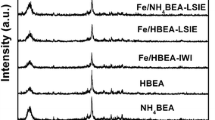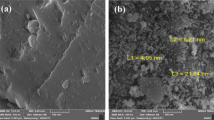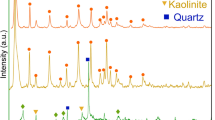Abstract
The current study aimed at exploring the potential of iron-embedded zeolites to serve as heterogeneous Fenton catalyst for the treatment of caffeine. Synthetic zeolites were modified through co-precipitation and subsequent deposition of iron precipitates on the zeolites. Catalyst was characterized through chemical composition, particle size and its distribution, BET specific surface area, FTIR, and XRD techniques. Batch mode studies were carried out, and process parameters including pH, contact time, and iron to hydrogen peroxide ratio (\(\hbox {Fe}^{+2}\):\(\hbox {H}_{2}\hbox {O}_{2})\) were optimized. Response surface methodology was employed for this purpose using Design Expert 10.0 software. \(\hbox {Fe}^{+2}\):\(\hbox {H}_{2}\hbox {O}_{2}\) ratio was found to be the most important parameter affecting the removal of caffeine. Significant interaction between pH and \(\text {Fe}^{+2}\):\(\hbox {H}_{2}\hbox {O}_{2}\) ratio was also observed. More than 80% removal of caffeine was achieved when the pH was in the range of 5.8–7 and \(\text {Fe}^{+2}\):\(\hbox {H}_{2}\hbox {O}_{2}\) ratio in the range of 2.5–3. Catalyst was found stable, and negligible loss of iron under experimental conditions was observed. Moreover, the catalyst could be reused for at least three successive runs of treatment without significant loss in the activity of the catalyst.
Similar content being viewed by others
References
Ellis, J.B.: Assessing sources and impacts of priority PPCP compounds in urban receiving waters. In: 11th International Conference on Urban Drainage, Edinburgh, Scotland, UK (2008)
Owens, B.: Pharmaceuticals in the environment: a growing problem. https://www.pharmaceutical-journal.com/news-and-analysis/features/pharmaceuticals-in-the-environment-agrowing-problem/20067898.article (2015). Accessed 25 Feb 2018
Reiner, J.; Berset, J.; Kannan, K.: Mass flow of polycyclic musks in two wastewater treatment plants. Arch. Environ. Contam. Toxicol. 52(4), 451–457 (2007)
Sui, Q.; Cao, X.; Lu, S.; Zhao, W.; Qiu, Z.; Yu, G.: Occurrence, sources and fate of pharmaceuticals and personal care products in the groundwater: a review. Emerg. Contam. 1(1), 14–24 (2015)
Wang, J.; Wang, S.: Removal of pharmaceuticals and personal care products (PPCPs) from wastewater: a review. J. Environ. Manag. 182, 620–640 (2016)
Bolong, N.; Ismail, A.; Salim, M.R.; Matsuura, T.: A review of the effects of emerging contaminants in wastewater and options for their removal. Desalination 239(1–3), 229–246 (2009)
Boxall, A.B.; Rudd, M.A.; Brooks, B.W.; Caldwell, D.J.; Choi, K.; Hickmann, S.; Innes, E.; Ostapyk, K.; Staveley, J.P.; Verslycke, T.: Pharmaceuticals and personal care products in the environment: what are the big questions? Environ. Health Perspect. 120(9), 1221 (2012)
Brooks, B.W.; Huggett, D.B.; Boxall, A.: Pharmaceuticals and personal care products: research needs for the next decade. Environ. Toxicol. Chem. 28(12), 2469–2472 (2009)
Daughton, C.G.: Pharmaceuticals and the environment (PiE): evolution and impact of the published literature revealed by bibliometric analysis. Sci. Total Environ. 562, 391–426 (2016)
Kümmerer, K.: Antibiotics in the aquatic environment—a review-part I. Chemosphere 75(4), 417–434 (2009)
Murdoch, K.: Pharmaceutical pollution in the environment: issues for Australia, New Zealand and Pacific island countries. Natl. Toxic Netw. 22, 1–36 (2015)
Buerge, I.J.; Poiger, T.; Müller, M.D.; Buser, H.-R.: Caffeine, an anthropogenic marker for wastewater contamination of surface waters. Environ. Sci. Technol. 37(4), 691–700 (2003)
Edwards, Q.A.; Kulikov, S.M.; Garner-O’Neale, L.D.: Caffeine in surface and wastewaters in Barbados, West Indies. SpringerPlus 4(1), 57 (2015)
Knee, K.L.; Gossett, R.; Boehm, A.B.; Paytan, A.: Caffeine and agricultural pesticide concentrations in surface water and groundwater on the north shore of Kauai (Hawaii, USA). Mar. Pollut. Bull. 60(8), 1376–1382 (2010)
Maryam Saad, D.F.S.; Khan, W.; Ijaz, A.; Qasim, M.; Hafeez, A.; Khan, A.; Baig, S.A.; Ahmed, N.: Occurrence of selected pesticides and PCPs in surface water receiving untreated discharge in Pakistan. J. Environ. Anal. Toxicol. 7(5), 500 (2017)
Bruton, T.; Alboloushi, A.; de la Garza, B.; Kim, B.-O.; Halden, R.U.: Fate of caffeine in the environment and ecotoxicological considerations. In: Contaminants of Emerging Concern in the Environment: Ecological and Human Health Considerations, vol. 1048. ACS Symposium Series, vol. 1048, pp. 257–273. American Chemical Society (2010)
Halden, R.U. (ed.): Contaminants of Emerging Concern in the Environment: Ecological and Human Health Considerations. American Chemical Society, Washington (2010)
Potera, C.: Caffeine in wastewater is a tracer for human fecal contamination. Environ. Health Perspect. 120(3), a108 (2012)
Stamatis, N.K.; Konstantinou, I.K.: Occurrence and removal of emerging pharmaceutical, personal care compounds and caffeine tracer in municipal sewage treatment plant in Western Greece. J. Environ. Sci. Health Part B 48(9), 800–813 (2013)
Sui, Q.; Huang, J.; Deng, S.; Yu, G.; Fan, Q.: Occurrence and removal of pharmaceuticals, caffeine and DEET in wastewater treatment plants of Beijing, China. Water Res. 44(2), 417–426 (2010)
del Rey, Z.R.; Granek, E.F.; Sylvester, S.: Occurrence and concentration of caffeine in Oregon coastal waters. Mar. Pollut. Bull. 64(7), 1417–1424 (2012)
Martín, J.; Camacho-Muñoz, D.; Santos, J.; Aparicio, I.; Alonso, E.: Occurrence of pharmaceutical compounds in wastewater and sludge from wastewater treatment plants: removal and ecotoxicological impact of wastewater discharges and sludge disposal. J. Hazard. Mater. 239, 40–47 (2012)
Al Qarni, H.; Collier, P.; O’Keeffe, J.; Akunna, J.: Investigating the removal of some pharmaceutical compounds in hospital wastewater treatment plants operating in Saudi Arabia. Environ. Sci. Pollut. Res. 23(13), 13003–13014 (2016)
Zhou, H.; Wu, C.; Huang, X.; Gao, M.; Wen, X.; Tsuno, H.; Tanaka, H.: Occurrence of selected pharmaceuticals and caffeine in sewage treatment plants and receiving rivers in Beijing, China. Water Environ. Res. 82(11), 2239–2248 (2010)
Moore, M.T.; Greenway, S.L.; Farris, J.L.; Guerra, B.: Assessing caffeine as an emerging environmental concern using conventional approaches. Arch. Environ. Contam. Toxicol. 54(1), 31–35 (2008)
Dafouz, R.; Cáceres, N.; Rodríguez-Gil, J.L.; Mastroianni, N.; de Alda, M.L.; Barceló, D.; de Miguel, Á.G.; Valcárcel, Y.: Does the presence of caffeine in the marine environment represent an environmental risk? A regional and global study. Sci. Total Environ. 615, 632–642 (2018)
Rey, Z.R.: Occurence and concentrations of caffeine in saewater from the Oregon coast and potential effects on dominant Mussel, Mytilus calfornians. M.Sc. Thesis. Portland State University (2010)
Ladu, F.; Mwaffo, V.; Li, J.; Macrì, S.; Porfiri, M.: Acute caffeine administration affects zebrafish response to a robotic stimulus. Behav. Brain Res. 289, 48–54 (2015)
Barone, R.; Nanna, M.P.; Patullo, C.: Effects of exposure to caffeine on the swimming behavior of the fathead minnow. Whalen Symposium Abstract (2017)
Al-Farsi, R.S.; Ahmed, M.; Al-Busaidi, A.; Choudri, B.: Translocation of pharmaceuticals and personal care products. (PPCPs) into plant tissues: a review. Emerg. Contam. 3(4), 132–137 (2018)
Wu, X.; Dodgen, L.K.; Conkle, J.L.; Gan, J.: Plant uptake of pharmaceutical and personal care products from recycled water and biosolids: a review. Sci. Total Environ. 536, 655–666 (2015)
Wang, J.; Gardinali, P.R.: Uptake and depuration of pharmaceuticals in reclaimed water by mosquito fish (Gambusia holbrooki): a worst-case, multiple-exposure scenario. Environ. Toxicol. Chem. 32(8), 1752–1758 (2013)
Grandclement, C.; Seyssiecq, I.; Piram, A.; Wong-Wah-Chung, P.; Vanot, G.; Tiliacos, N.; Roche, N.; Doumenq, P.: From the conventional biological wastewater treatment to hybrid processes, the evaluation of organic micropollutant removal: a review. Water Res. 111, 297–317 (2017)
Roth, O.: Evaluating the effectiveness of three Utah wastewater treatment facilities in removing pharmaceuticals and personal care products. Msc Thesis, Utah State University (2012)
Commission, E.: Directive 2013/39/EU of the European Parliament and of the Council of 12 August 2013 amending Directives 2000/60/EC and 2008/105/EC as regards priority substances in the field of water policy. Off. J. Eur. Union 226, 1–17 (2013)
Ebrahiem, E.E.; Al-Maghrabi, M.N.; Mobarki, A.R.: Removal of organic pollutants from industrial wastewater by applying photo-Fenton oxidation technology. Arab. J. Chem. 10, S1674–S1679 (2017)
Oliveira, T.D.D.; Martini, W.S.; Santos, M.D.; Matos, M.A.C.; Rocha, L.L.D.: Caffeine oxidation in water by Fenton and Fenton-like processes: effects of inorganic anions and ecotoxicological evaluation on aquatic organisms. J. Braz. Chem. Soc. 26(1), 178–184 (2015)
Meng, X.; Yan, S.; Wu, W.; Zheng, G.; Zhou, L.: Heterogeneous Fenton-like degradation of phenanthrene catalyzed by schwertmannite biosynthesized using Acidithiobacillus ferrooxidans. RSC Adv. 7(35), 21638–21648 (2017)
Trovó, A.G.; Silva, T.F.; Gomes, O.; Machado, A.E.; Neto, W.B.; Muller, P.S.; Daniel, D.: Degradation of caffeine by photo-Fenton process: optimization of treatment conditions using experimental design. Chemosphere 90(2), 170–175 (2013)
Klamerth, N.; Malato, S.; Maldonado, M.; Aguera, A.; Fernández-Alba, A.: Application of photo-fenton as a tertiary treatment of emerging contaminants in municipal wastewater. Environ. Sci. Technol. 44(5), 1792–1798 (2010)
Trovó, A.G.; Silva, T.F.; Gomes Jr., O.; Machado, A.E.; Neto, W.B.; Muller Jr., P.S.; Daniel, D.: Degradation of caffeine by photo-Fenton process: optimization of treatment conditions using experimental design. Chemosphere 90(2), 170–175 (2013)
Yamal-Turbay, E.; Graells, Ms; Pérez-Moya, M.: Systematic assessment of the influence of hydrogen peroxide dosage on caffeine degradation by the photo-Fenton process. Ind. Eng. Chem. Res. 51(13), 4770–4778 (2012)
Rodríguez-Gil, J.L.; Catalá, M.; Alonso, S.G.; Maroto, R.R.; Valcárcel, Y.; Segura, Y.; Molina, R.; Melero, J.A.; Martínez, F.: Heterogeneous photo-Fenton treatment for the reduction of pharmaceutical contamination in Madrid rivers and ecotoxicological evaluation by a miniaturized fern spores bioassay. Chemosphere 80(4), 381–388 (2010)
Ganzenko, O.; Oturan, N.; Huguenot, D.; Van Hullebusch, E.D.; Esposito, G.; Oturan, M.A.: Removal of psychoactive pharmaceutical caffeine from water by electro-Fenton process using BDD anode: effects of operating parameters on removal efficiency. Sep. Purif. Technol. 156, 987–995 (2015)
Klavarioti, M.; Mantzavinos, D.; Kassinos, D.: Removal of residual pharmaceuticals from aqueous systems by advanced oxidation processes. Environ. Int. 35(2), 402–417 (2009)
Bernabeu, A.; Vercher, R.; Santos-Juanes, L.; Simón, P.; Lardín, C.; Martínez, M.; Vicente, J.; González, R.; Llosá, C.; Arques, A.: Solar photocatalysis as a tertiary treatment to remove emerging pollutants from wastewater treatment plant effluents. Catal. Today 161(1), 235–240 (2011)
Gonzalez-Olmos, R.; Kopinke, F.-D.; Mackenzie, K.; Georgi, A.: Hydrophobic Fe-zeolites for removal of MTBE from water by combination of adsorption and oxidation. Environ. Sci. Technol. 47(5), 2353–2360 (2013)
Ünnü, B.A.; Gündüz, G.; Dükkancı, M.: Heterogeneous Fenton-like oxidation of crystal violet using an iron loaded ZSM-5 zeolite. Desalin. Water Treat. 57(25), 11835–11849 (2016)
Kim, K.S.; Park, J.O.; Nam, S.C.: Synthesis of iron-loaded zeolites for removal of ammonium and phosphate from aqueous solutions. Environ. Eng. Res. 18(4), 267–276 (2013)
Qi, F.; Chu, W.; Xu, B.: Modeling the heterogeneous peroxymonosulfate/Co-MCM41 process for the degradation of caffeine and the study of influence of cobalt sources. Chem. Eng. J. 235, 10–18 (2014)
Guo, Y.; Shen, T.; Wang, C.; Sun, J.; Wang, X.: Rapid removal of caffeine in aqueous solutions by peroxymonosulfate oxidant activated with cobalt ion. Water Air Soil Pollut. 72(3), 478–483 (2015)
Ranga, S.; Jaimini, M.; Sharma, S.K.; Chauhan, B.S.; Kumar, A.: A review on design of experiments (DOE). Int. J. Pharm. Chem. Sci. 3(1), 216–224 (2014)
Tamura, H.; Goto, K.; Yotsuyanagi, T.; Nagayama, M.: Spectrophotometric determination of iron (II) with 1, 10-phenanthroline in the presence of large amounts of iron (III). Talanta 21(4), 314–318 (1974)
Jacqueline George, S.; Gandhimathi, R.; Nidheesh, P.V.; Ramesh, S.T.: Optimization of salicylic acid removal by electro Fenton process in a continuous stirred tank reactor using response surface methodology. Desalin. Water Treat. 57(9), 4234–4244 (2016)
Louhichi, B.; Bensalah, N.: Comparative study of the treatment of printing ink wastewater by conductive-diamond electrochemical oxidation, Fenton process, and ozonation. Environ. Res. 24(1), 49–58 (2014)
Canizares, P.; Paz, R.; Sáez, C.; Rodrigo, M.A.: Costs of the electrochemical oxidation of wastewaters: a comparison with ozonation and Fenton oxidation processes. J. Environ. Manag. 90(1), 410–420 (2009)
Funding
This research was funded by University of Engineering and Technology, Lahore, Pakistan.
Author information
Authors and Affiliations
Corresponding author
Ethics declarations
Conflict of interest
The authors declare that they have no conflict of interest.
Rights and permissions
About this article
Cite this article
Anis, M., Haydar, S. Heterogeneous Fenton Oxidation of Caffeine Using Zeolite-Supported Iron Nanoparticles. Arab J Sci Eng 44, 315–328 (2019). https://doi.org/10.1007/s13369-018-3659-3
Received:
Accepted:
Published:
Issue Date:
DOI: https://doi.org/10.1007/s13369-018-3659-3




